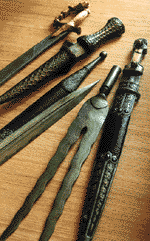The appearance of the Karaims in Lithuania and the name of Vytautas the Grand Duke of Lithuania are in a close relation. There are a bunch of poetic works and songs about Vytautas in the Karaim language in which he is named Vatat Bij (“the King crushing his enemies”), about the town of Trakai and the beauty of Lithuania. These highly appreciated, intimate and even sacred topics have already become symbols to the Karaims.

a lithograph of 1930.
Photo by Zinas Kazėnas
Vytautas is a descendant of a genuine Lithuanian duke family. He was the fourth child of Great Duke Kęstutis and is supposed to be the first-born son of the Great duchess Birutė. In 1370, as the chronicle of Konrad Bitchin narrates, Vytautas, at the age of twenty, participated in the battle of Rudava. Consequently, he probably was born in 1350.
Vytautas grew up in time of incessant battlefields; therefore the military issues prevailed in his education. Even since 1368, he started to take the different military fields. In 1379, the personal seal of Vytautas appeared for the first time.
Vytautas ran away from Lithuania twice and stayed about four years in Prussia. There he received the education at the school of life. The State of the Order of the Knights of the Cross, which existed already for some centuries, was highly influenced by the West Christian culture and could have had favourable effect upon ingenious Vytautas. This country contributed to his political intelligence also.
Vytautas was both an ingenious statesman and an excellent military commander. Often he took part in the battles himself and never avoided them. In 1392, he finally renounced the union with the Order of the Knights of the Cross, reconciled himself to the King Jogaila and the Poles, and commenced to rule not only his patrimony but also the whole Lithuania.
Feeling sufficiently powerful, he began pursuing an independent policy in the East. The concept “East” covers two directions of feat of arms: the first one -to Russia, and the second one- to the Tatar territories. In 1390, the cruel ruler of the Middle and East Asia Tamerlan (Timur) banished the ruler of the Golden Horde Tokhtamysh who was unable to gain a foothold in the Eastern Europe and rule over the Russian territories. Tokhtamysh found refuge by Vytautas and this was how the latter got involved in the internal Tatar war.
In 1397, Vytautas organized a great feat of arms to the Southeast. And he succeeded: the Azov Horde was beaten up. Numerous captives were taken and settled in uninhabited territories of Russia and Lithuania. The next year, Vytautas again set out for the Tatar Land. It is said that during this feat of arms the distance of 200 miles from Vilnius was covered, that the Tatars yielded themselves captives and that Vytautas having built a castle from clay in three weeks named it Johannesburg (Tavan).

Photo by Zinas Kazėnas
The years of 1397 and 1398 are related to the coming of the Karaims to Lithuania. Since we lack exact historical information on this subject, it is also unclear where in the Black Sea region Vytautas could encounter the Karaims. During that time, there occurred three battles between the Lithuanian army and the Tatars: the first one, in the year of 1397, in the lands of the Azov Horde, and the second and third ones, in the year of 1398, near Kaffa (now Feodosia) and Solkhat (now Staryj Krym).
Vytautas brought the Karaims (several hundred of families) home as warriors and honest servants. They were settled between the two castles of the Ruler in Trakai, and in other locations near the Lithuanian border: Biržai, Pasvalys, Pušalotas, Naujamiestis, Panevėžys. Vytautas and other rulers of Lithuania expressed their confidence to the Karaims by affording the privileges to the Karaim communities. The first preserved document bearing the testimony of the Magdebourg Rights (self-governing) afforded to the Karaim community descends from the year of 1441. The Grand Duke Jonas Kazimieras signed it. In possession of the self-governing, the Karaims were under direct authority of the elected vaitas of Trakai who possessed administrative and legal power. Vaitas was responsible to the highest Lithuanian ruler.
The Karaims were loyal to the Lithuanian rulers, protected their castles, practiced medicine, and worked as translators. The relationships between the Grand Duke of Lithuania and the Karaims were always good. This is witnessed by respect of the Karaims towards Vytautas remained until now and even some kind of Vytautas’ cult (narratives, legends, verses). Many of the Karaims even have a picture of Vytautas at home. In 1930, during the 500-year remembrance of Vytautas’ death in Lithuania, a Requiem was held in the Vilnius kenesa.

